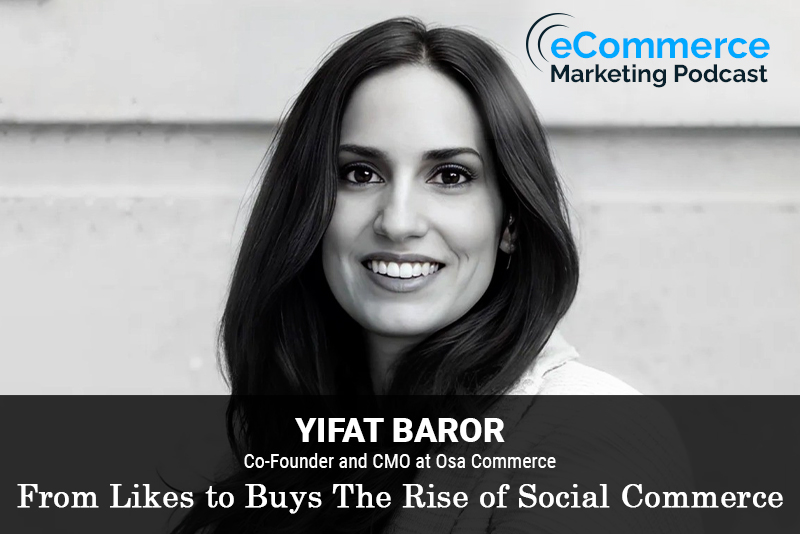
The eCommerce Marketing Podcast walks you through everything that goes into ecommerce marketing — from inbound marketing to paid advertising to conversions. Learn the strategies top marketing experts use to grow their businesses.
Head over to Leadfeeder.com and sign up for a 14-day (no strings attached) free trial!
Yifat Baror is the Co-founder, CMO, and Chief Growth Officer at Osa Commerce. With almost two decades of experience in E-commerce, Yifat has consistently driven global growth for omnichannel retail. Her track record includes leading GTM strategy, brand building, and high-growth teams. Yifat also founded and managed a multi-million dollar retail business that distributed contemporary brands internationally. Yifat was awarded the SDCE Executive’s 2022 and 2023 Women in Supply Chain award.
In this episode, you will learn
- How the landscape of social commerce evolves, and the major shifts in consumer behavior on platforms like Instagram, TikTok, and Facebook
- Strategies that are crucial for brands to successfully integrate their e-commerce efforts with social media platforms
- How emerging technologies, such as AI, AR, and VR, will impact the future of social commerce
- Key insights and lessons for aspiring female leaders in the e-commerce and supply chain industries
- Trends and developments that will predict and shape the future of social commerce in the next 5 to 10 years and how should brands and marketers prepare for these changes
For show transcript and past guests, please visit https://www.ecommercemarketingpodcast.com
Or on YouTube at:
https://www.youtube.com/channel/UC3PgT0NOGzpdPGQtBK0XLIQ
Follow Arlen:
Twitter: https://twitter.com/askarlen
Facebook: https://www.facebook.com/arlen.robinson.7
Instagram: https://www.instagram.com/arlenyohance/
LinkedIn: https://www.linkedin.com/in/arlenrobinson/
Past guests on the ecommerce marketing podcast include Neil Patel, Nemo Chu, Luke Lintz, Luke Carthy, Amber Armstrong, Kris Ruby and many more.
Thanks for listening. Be sure to subscribe and leave a review.

In this episode of the eCommerce Marketing Podcast, host Arlen Robinson interviews Yifat Baror, Co-founder, CMO, and Chief Growth Officer at Osa Commerce. With nearly two decades of experience in e-commerce, Yifat has a strong background in driving global growth for omnichannel retail and leading high-growth teams. She shares her insights on the evolution of social commerce, the importance of seamless customer experiences, and the role of technology in supporting e-commerce businesses.
Key Takeaways
- Introduction and Background ([00:01] – [03:00])
- Yifat’s extensive experience in e-commerce, from running retail stores to leading a SaaS company
- The evolution of social commerce and the importance of creating engaging customer experiences
- The Rise of Social Commerce ([03:00] – [08:24])
- The seamless shopping experience on platforms like TikTok, which keeps users within the platform for transactions
- The shift from traditional e-commerce to integrated social commerce
- Importance of Backend Integration ([08:24] – [12:12])
- The need for a strong technology partner to ensure smooth backend operations and customer satisfaction
- The risk of losing customers due to poor post-purchase experiences
- Key Strategies for Social Commerce Success ([12:12] – [13:37])
- Understanding your ideal customer profile
- Investing in technology to support backend operations and ensure a seamless customer journey
- Challenges and Overcoming Them ([13:37] – [17:57])
- The challenges faced by brands in leveraging social commerce
- The importance of backend support to handle peaks in sales and ensure smooth inventory management
- Impact of Emerging Technologies ([17:57] – [21:47])
- The role of AI, AR, and VR in enhancing social commerce
- Using AI for market research and content creation, while maintaining the brand’s unique voice
- Insights for Female Leaders ([21:47] – [23:18])
- The importance of a strong support network and mentorship
- Being open to learning and asking for help
- Future Trends in Social Commerce ([23:18] – [26:04])
- The growing importance of understanding Gen Z’s shopping behaviors
- The rise of resale markets and the need for brands to create long-term customer relationships
- Personal Fun Fact and Final Advice ([27:17] – [29:40])
- Yifat’s belief in the importance of taking time to rest and meditate for better creativity and productivity
Podcast Guest Info
Yifat Baror
Co-Founder and CMO at Osa Commerce
LinkedIn: Yifat Baror











